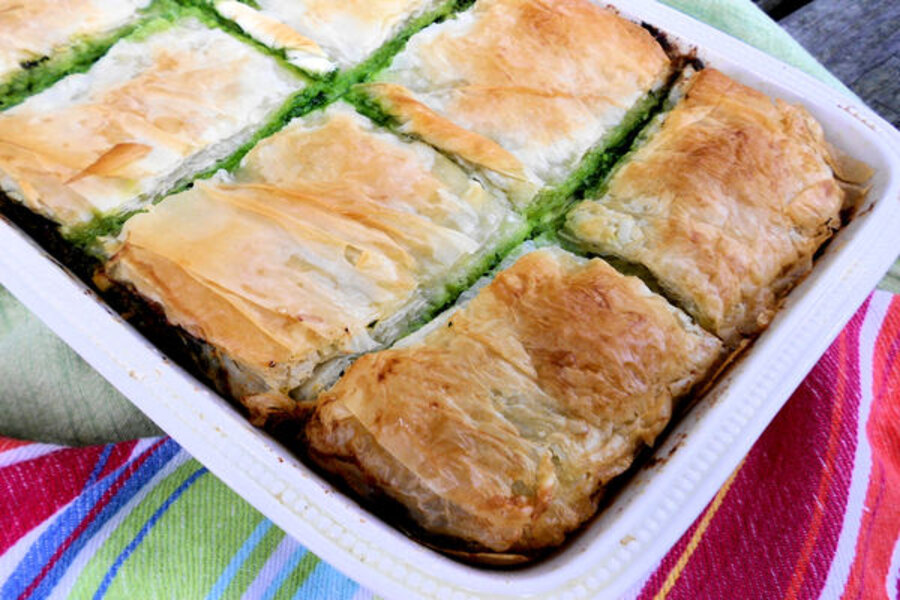How to grow and cook spinach
Loading...
Spinach likes it cool, says Anne Moore, the gardener. Plant it early in the season for a spring crop or late for a winter crop. If planted after the soil heats up, the seeds might not germinate. For a winter crop, you might have to sow it indoors where you can regulate the soil temperature.
Bloomsdale Long-Standing spinach is a reliable, old-fashioned spinach. It is slow to bolt (a seed stalk shoots up from the center of the plants, turning the leaves bitter.) Use it anywhere the weather jumps from cool to hot with little “spring” in between.
New Zealand spinach and Malabar spinach make good hot-climate spinach substitutes. In the South, you can sow either directly into the soil after all danger of frost has passed. Despite their names, neither are spinach but they taste much the same. Both can be eaten raw or cooked slowly as you would other greens.
New Zealand spinach seed should be soaked for 24 hours before planting. It actually is a cluster of seeds (like beet seed) and will come up thickly and need thinning once it establishes in the garden.
You should scarify Malabar spinach seed (scratch it with a file or knife). This helps to speed germination, although my preferred speed-up is soaking. It is a vine with red stems and glossy green leaves, showy enough to run up a trellis amongst your ornamental plants.
Grow any of the spinaches or subs in well-draining soil. Keep the seedbed moist until the seeds sprout. Then water whenever the soil dries out about an inch deep.
If the plants wilt during the heat of the day, check the soil with your finger before you add water. Over-watering can promote root rot and fungus infections.
Spinach recipe - Spanakopita
The first time I took cooking lessons, almost 40 years ago, was at a Greek cooking class, says chef Linda Weiss. The two recipes that we learned that night were spanakopita, and baklava. We made the spanakopita with frozen spinach that we thawed and squeezed almost dry before adding to the recipe. I made this recipe, below and in the photograph above, with fresh baby spinach. It has a different color and texture. I think you’ll like it. I sure do.
1/2 package phyllo dough, thawed *
10 tablespoons melted butter
10 ounces reduced-fat ricotta cheese
10 ounces reduced-fat feta cheese, crumbled
2-1/2 tablespoons finely grated Romano cheese
2 eggs, beaten
1 pound fresh baby spinach, finely chopped, or chopped in food processor
1 tablespoon olive oil
3 green onions with 3 inches of tender stems, chopped
1-1/2 tablespoons finely chopped dill
Pepper to taste
Preheat oven to 375 degrees F.
If phyllo dough is frozen, place in refrigerator to thaw.
Once phyllo has thawed, melt butter and set aside.
Unroll thawed phyllo dough and cut in half by width to fit a 9-by-9-inch oven-proof pan or the equivalent in volume. (I used a 7-by-11-inch pan and staggered the filo dough). Butter the baking pan and set aside.
Heat olive oil in a small skillet. Add green onions and sauté until tender. Set aside.
Prepare spinach and place in a large bowl. Add eggs, cheeses, green onions with the olive oil, dill, and pepper to the spinach. You will have about 6 cups of mixture.
In the buttered baking pan, add 8 layers of phyllo dough, brushing each layer with butter. Spread 2 cups of the spinach-cheese mixture over the phyllo. Add 8 more layers of phyllo dough, brushing each layer with butter. Spread 2 more cups of spinach-cheese mixture, and layer again with 8 buttered layers of dough. Spread the final 2 cups of the spinach-cheese mixture, and then add 14 layers of phyllo dough, brushing each layer with butter and making sure you brush the top layer with butter as well. Cut the pastry into equal pieces with a sharp knife and bake for 40 minutes or until top is golden brown. Let rest 20 minutes before serving. Serves 6 to 8.
* There are two rolls of phyllo dough in most packages. Each inside roll has 20 layers. Unroll one and cut it in half by width. This will give you 40 sheets. Make sure you keep it covered with a slightly damp cloth; otherwise, it will feel like paper crumbling in your hand when you try to pick it up.
Editor's Note: To read more of Anne and Linda's "how to grow and prepare" series, click here.
Linda Weiss is a personal chef. She attended Le Cordon Bleu of Paris’ catering program and is a professional member of The James Beard Foundation and the Southern Foodways Alliance. Her cookbook is "Memories From Home, Cooking with Family and Friends." Anne Moore is an award winning free lance writer. She is the horticulture editor, gardening consultant, and newsletter editor for GardenSmart.tv. She is a member of the Garden Writers Association. Follow Linda & Anne as they blog at www.thegardenerandthechef.com







